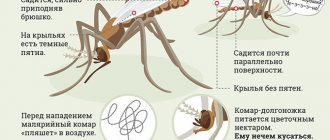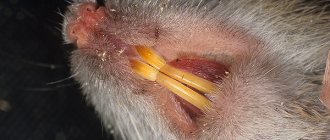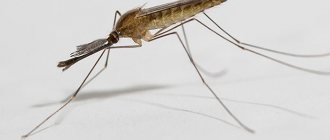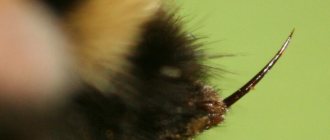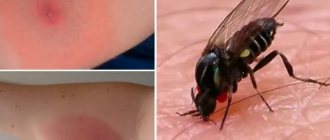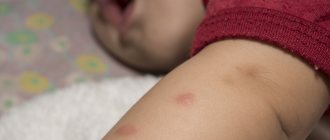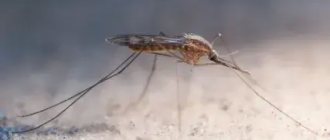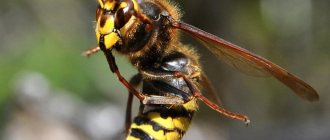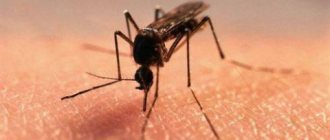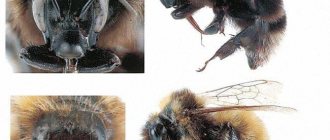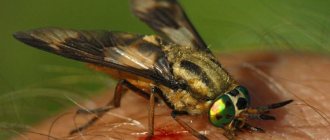Malarial mosquitoes are distributed throughout the globe, but they pose the greatest risk and danger in tropical and subtropical countries. In Russia, the maximum number of cases of infection is recorded in the southern regions, which border on countries included in the global habitat of malaria mosquitoes. Rare cases of transmission of the infectious disease pathogen also occur in other regions of the country.
First of all, it is necessary to indicate how a malaria mosquito differs from a regular one. Many people confuse it with the centipede, a large insect with large wings and long limbs. But the malaria mosquito looks like a regular one. You can recognize it by the following signs:
- the length of the limbs is twice the length of the body;
- antennae (tentacles near the mouthparts) are almost identical in size to the proboscis;
- There are no scales on the abdomen, it is covered with hairs.
Difference from ordinary mosquitoes
A malaria mosquito can be identified by the position of its body on a horizontal surface.
The hind limbs of the insect are significantly longer than the front ones. Because of this, during rest, the body of the malaria mosquito takes on an almost vertical position, while in an ordinary representative of the family it is distinguished by a parallel arrangement. A malaria mosquito bite can lead to various consequences. The degree of complication depends on the type of insect, its habitat, and the body’s susceptibility to infection. Diptera vectors of the disease cause the development of three-day, four-day and tropical fever. It is the latter form of the disease that claims many lives every year. In Russia, only imported cases of tropical fever are found.
What happens if you are bitten by a malaria mosquito?
Only the female malaria mosquito needs to feed on blood. She needs protein and other nutrients for successful reproduction and maturation of eggs. Males do not attack people or animals. Their main source of energy is carbohydrates from plant juice.
What will happen to a person if he is bitten by a malaria mosquito? The consequences and degree of complications depend, first of all, on the species of the insect and the individual characteristics of the victim’s immune system. Symptoms can manifest themselves in the form of local allergic reactions and a general deterioration in health, disruption of the functioning of various organs and systems of the body.
During a bite, a malaria mosquito, along with saliva, releases spores into the human blood and lymph, which become the cause of the development of a dangerous infectious disease. In this case, for infection, a dose of sporozoites is sufficient, which enters the body after one insect bite. The victim's blood becomes a potential source of infection. If a healthy mosquito attacks such a person or animal, it will infect its next hosts with malaria. Blood containing dangerous spores should not be used for transfusion. During pregnancy, the infection can pass from mother to fetus.
Why is malaria dangerous?
Malaria is life threatening because it affects various organs and can cause:
- parasitic infection of the body;
- acute impairment of all renal functions;
- heart failure;
- accumulation of fluid in the brain (brain edema);
- mental disorders;
- malarial coma followed by death.
How the disease develops is determined by the type of pathogen. Children under 5 years of age experience the disease more severely than older patients.
What does a malaria mosquito bite look like?
If you look at what a bite from a regular mosquito and a malaria mosquito looks like, it becomes obvious that there are no significant differences in the local allergic reaction. This significantly complicates and prevents the initiation of surgical treatment. A slight swelling, redness, and small nodule forms at the site of the lesion. Similar signs are characteristic of the bite of a non-malarial mosquito. Identification is further complicated by the fact that each person’s body reacts individually to attacks by blood-sucking parasites, and it is impossible to clearly determine without laboratory tests what the complications are associated with.
Signs of fever may appear only after a few days in the form of chills, severe weakness, nausea and vomiting, and increased body temperature. In this case, you should immediately contact a medical institution for professional help. You should not hope that the body will cope with the infection on its own if the patient feels better after 2-3 days. This is due only to the cyclical course of the disease.
Malaria screenings
To make a diagnosis in the infectious diseases department:
- are interviewed for complaints;
- blood is taken for general and biochemical analysis;
- smears are examined for the presence of parasites. To do this, blood from a vein and finger is examined;
- urine is taken for general analysis.
As a rule, the first test does not confirm the disease, so blood is taken again after a few hours.
With malaria, the following changes in the composition of the blood will be found:
- decreased hemoglobin levels and red blood cell levels;
- increased concentration of leukocytes and platelets;
- the color index may be reduced or within normal limits.
The urine will contain hemoglobin, blood clots and red blood cells. Blood biochemistry will show an increase in bilirubin, ALT and AST, albumin.
The doctor makes a diagnosis based on information about a person’s stay in regions where swamp fever is widespread, based on characteristic symptoms, and also based on the results of laboratory tests.
Symptoms of a malaria mosquito bite
The bite of a malaria mosquito is less noticeable than the attack of ordinary representatives of the family. It is accompanied by mild painful sensations, which a person may sometimes not notice. The reaction of the skin and body to an insect bite is caused by mechanical damage to the epidermis and the toxic effects of saliva containing components that prevent coagulation.
Typically, the symptoms of a malaria mosquito bite are a small red spot on the skin and a small nodule. After an attack by other species of this family, a person may experience a burning sensation, itching and a blister up to 1-1.2 cm in size. Symptoms largely depend on the individual characteristics of the victim, the species composition and the number of attacking insects.
Consequences of a malaria mosquito bite
Among infectious diseases, malaria ranks first in the world in terms of deaths. The cause of the development of infection in the human body is malarial plasmodium, which is transmitted from a mosquito during a bite. Blood and lymph carry the source of infection to different systems, organs and tissues. The body's response to malarial plasmodium manifests itself in the form of a change in immune status and an increase in body temperature as a result of the destruction of red blood cells. Malaria is characterized by a cyclical course, when attacks of fever are replaced by periods of imaginary improvement in well-being. The lack of prompt professional medical care increases the risk of death several times.
The consequences of an attack by a malaria mosquito, like other blood-sucking insects, can manifest themselves in different forms:
- Local allergic reaction. A few minutes after the bite, redness, inflammation, and swelling form on the skin area. The person begins to be bothered by itching and burning. In some cases, suppuration may develop. Severe allergic reactions often occur in victims with chronic illnesses and in patients with immunocompromised conditions.
- Papular urticaria. This is the appearance of itchy papules on the arms, legs, neck, back, scalp and other open areas of the body. This form of allergic reaction is typical for hypersensitive people and children under 10 years of age.
- Systemic allergic reactions. Malaria mosquito bites are rare in response to bites. They are most typical for patients with urticaria pigmentosa, who have mastocytes - clusters of mast cells - in their internal organs and skin.
- General deterioration of health and reaction of other systems and organs: chills, increased body temperature, drowsiness, nausea, vomiting, headache.
The consequences of a malarial and ordinary mosquito bite are largely determined by genetic characteristics. In the course of research and analysis, scientists have found that women are more desirable prey for dipteran blood-sucking carriers of a dangerous infection than men. In addition, the weaker sex is more prone to acute allergic reactions.
Interesting
The consequences of an attack by a malaria mosquito depend on the type of plasmodium that has entered the blood and lymph.
They are characterized by different symptoms, the degree of their manifestation, severity and likelihood of death. Three-day malaria is the least dangerous. The incubation period of the disease ranges from 8 to 16 days. Every 48 hours, the victim is reported to have bouts of fever. Other symptoms of infection: general weakness and lethargy, chills, drowsiness, enlarged spleen and liver.
Four-day malaria can cause death if the patient is not provided with professional medical assistance in a timely manner. The incubation period of the disease is 20-35 days. The victim experiences fever attacks every 72 hours. Kidney damage is also noted.
The most dangerous form of malaria is tropical. It has the highest risk of death. The disease manifests itself 7-12 days after the bite of a malaria mosquito. Irregular attacks of fever and obstruction of capillaries often cause death.
Interesting Facts
Malaria mosquitoes are fraught with many interesting and secret things.
We know little about them, but the facts below can reveal many secrets:
- Anopheles is included in the Guinness Book of Records. It is considered the most dangerous insect on Earth;
- They are carriers of a dangerous disease - malaria. Every year, 200 million people die from it on the planet;
- Bloodsuckers of the Anopheles species are found where there are foci of malaria. In other areas, encountering them is very rare;
- The insect's flight speed is 3.2 km/hour;
- Females are larger than males. The body size of insects is 12.5-13 mm. However, there is evidence that previously there were huge individuals with a body length of 5 cm;
- Unlike ordinary mosquitoes, Anopheles mosquitoes have a slightly raised back part of their body. They also move parallel to the surface;
- Insects see through the prism of an infrared beam, so they can quickly find people and animals even in complete darkness;
- To get enough, mosquitoes can fly long distances (up to 65 kilometers);
- In 1 second, an insect flaps its wings 600 times. This is what creates the unpleasant sound that comes from mosquitoes - squeaking;
- According to scientific research, it has been found that mosquitoes often attack people who are very sweaty. They find the victim by body odor and exhaled carbon dioxide;
- The development cycle from egg to adult is only 4 days;
- Mosquitoes are nocturnal insects and this is when they begin to attack. Their activity increases by almost 500% during the full moon.
Malaria mosquito: bite and treatment
Is the malaria mosquito dangerous in Russia? What forms of fever are found in our country? What to do if attacked by a malaria mosquito, how to distinguish its bite, and is it worth starting self-treatment? Let's try to find answers to the above questions.
In Russia and neighboring CIS countries, the majority of registered cases of the disease are imported tropical malaria. But on the territory of our country, especially in its southern part, there are conditions for the emergence of local outbreaks. Rare cases of three-day fever are also recorded in Moscow, the Moscow region and other regions of Russia.
About the vaccine
To date, there is no effective vaccine against malaria.
Prevention of malarial plasmodia and personal protective equipment against mosquito bites are the only tactics to prevent the spread of a dangerous infectious disease. What to do if you are sure that you have been bitten by a malaria mosquito? You should seek professional medical help immediately. The faster competent treatment is organized, the easier it will be to overcome the disease and the lower the likelihood of complications developing. The main drug used to combat Plasmodium falciparum is quinine. The doctor selects other medications taking into account the patient’s condition and the degree of allergic reactions. If you do not seek help from specialists in time, the disease may become chronic, and the central nervous system and other body systems will begin to malfunction.
If you want to protect your area from mosquitoes and other midges, contact the specialists of SES “Des Group” for help. They will quickly treat the object against blood-sucking insects that carry the infection. You can contact us and clarify the cost of the service by phone.
Calculator
Calculate the cost of exterminating insects on the site
Where do bloodsuckers live - carriers of infections?
The regions where the malaria mosquito lives are marked in red.
Malaria mosquitoes are adapted to life on almost all continents. They are absent only in areas with extremely cold climates. To reproduce, they need bodies of water, on the surface of which they lay eggs. The larva hatches from the egg and remains in the water until it grows into an adult mosquito. However, not every body of water is suitable for their reproduction - insects will not lay eggs in thickets of duckweed and reeds, or in acidic water (wastewater). Mosquitoes choose bodies of water with clean water, algae, which are long and short threads, where it is convenient for the larvae to hide.
Attention! In Russia, several dozen species occupy large territories for their habitat. The common malaria mosquito (Anopheles maculipennis), with 5 twin species, lives in the European part. In the summer, the Republic of Tatarstan and Kazan suffer from them.
The counterpart of the common malaria mosquito - Anopheles messeae, except for the European part, lives beyond the Ural Mountains (the range extends to Mongolia), in the Amur region. The most cold-resistant mosquito that lives in the taiga is Anopheles beklemishevi. It lives where even the malaria pathogen cannot survive.
